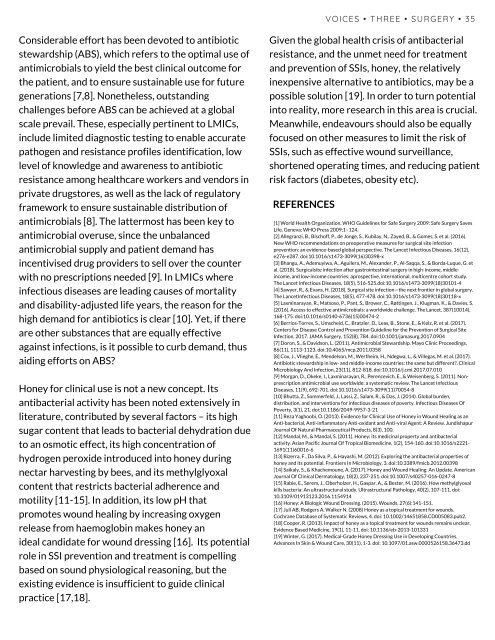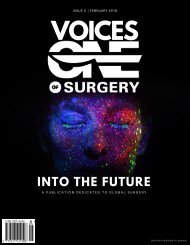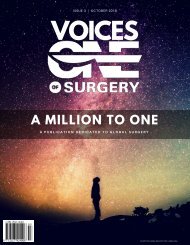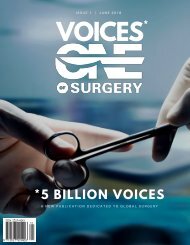Safety First - Voices of One Surgery - Issue 4: December 2018
As we celebrate 10 years of the launch of the World Health Organisation Surgical Safety Checklist and the success it gave, One.Surgery recognises the many challenges that still exist today in the pursuit of providing safe surgery to every patient worldwide.
As we celebrate 10 years of the launch of the World Health Organisation Surgical Safety Checklist and the success it gave, One.Surgery recognises the many challenges that still exist today in the pursuit of providing safe surgery to every patient worldwide.
You also want an ePaper? Increase the reach of your titles
YUMPU automatically turns print PDFs into web optimized ePapers that Google loves.
VOICES • THREE • SURGERY • 35<br />
Considerable effort has been devoted to antibiotic<br />
stewardship (ABS), which refers to the optimal use <strong>of</strong><br />
antimicrobials to yield the best clinical outcome for<br />
the patient, and to ensure sustainable use for future<br />
generations [7,8]. Nonetheless, outstanding<br />
challenges before ABS can be achieved at a global<br />
scale prevail. These, especially pertinent to LMICs,<br />
include limited diagnostic testing to enable accurate<br />
pathogen and resistance pr<strong>of</strong>iles identification, low<br />
level <strong>of</strong> knowledge and awareness to antibiotic<br />
resistance among healthcare workers and vendors in<br />
private drugstores, as well as the lack <strong>of</strong> regulatory<br />
framework to ensure sustainable distribution <strong>of</strong><br />
antimicrobials [8]. The lattermost has been key to<br />
antimicrobial overuse, since the unbalanced<br />
antimicrobial supply and patient demand has<br />
incentivised drug providers to sell over the counter<br />
with no prescriptions needed [9]. In LMICs where<br />
infectious diseases are leading causes <strong>of</strong> mortality<br />
and disability-adjusted life years, the reason for the<br />
high demand for antibiotics is clear [10]. Yet, if there<br />
are other substances that are equally effective<br />
against infections, is it possible to curb demand, thus<br />
aiding efforts on ABS?<br />
Honey for clinical use is not a new concept. Its<br />
antibacterial activity has been noted extensively in<br />
literature, contributed by several factors – its high<br />
sugar content that leads to bacterial dehydration due<br />
to an osmotic effect, its high concentration <strong>of</strong><br />
hydrogen peroxide introduced into honey during<br />
nectar harvesting by bees, and its methylglyoxal<br />
content that restricts bacterial adherence and<br />
motility [11-15]. In addition, its low pH that<br />
promotes wound healing by increasing oxygen<br />
release from haemoglobin makes honey an<br />
ideal candidate for wound dressing [16]. Its potential<br />
role in SSI prevention and treatment is compelling<br />
based on sound physiological reasoning, but the<br />
existing evidence is insufficient to guide clinical<br />
practice [17,18].<br />
Given the global health crisis <strong>of</strong> antibacterial<br />
resistance, and the unmet need for treatment<br />
and prevention <strong>of</strong> SSIs, honey, the relatively<br />
inexpensive alternative to antibiotics, may be a<br />
possible solution [19]. In order to turn potential<br />
into reality, more research in this area is crucial.<br />
Meanwhile, endeavours should also be equally<br />
focused on other measures to limit the risk <strong>of</strong><br />
SSIs, such as effective wound surveillance,<br />
shortened operating times, and reducing patient<br />
risk factors (diabetes, obesity etc).<br />
REFERENCES<br />
[1] World Health Organization. WHO Guidelines for Safe <strong>Surgery</strong> 2009: Safe <strong>Surgery</strong> Saves<br />
Life. Geneva: WHO Press 2009;1–124.<br />
[2] Allegranzi, B., Bisch<strong>of</strong>f, P., de Jonge, S., Kubilay, N., Zayed, B., & Gomes, S. et al. (2016).<br />
New WHO recommendations on preoperative measures for surgical site infection<br />
prevention: an evidence-based global perspective. The Lancet Infectious Diseases, 16(12),<br />
e276-e287. doi:10.1016/s1473-3099(16)30398-x<br />
[3] Bhangu, A., Ademuyiwa, A., Aguilera, M., Alexander, P., Al-Saqqa, S., & Borda-Luque, G. et<br />
al. (<strong>2018</strong>). Surgicalsite infection after gastrointestinal surgery in high-income, middleincome,<br />
and low-income countries: aprospective, international, multicentre cohort study.<br />
The Lancet Infectious Diseases, 18(5), 516-525.doi:10.1016/s1473-3099(18)30101-4<br />
[4] Sawyer, R., & Evans, H. (<strong>2018</strong>). Surgical site infection—the next frontier in global surgery.<br />
The LancetInfectious Diseases, 18(5), 477-478. doi:10.1016/s1473-3099(18)30118-x<br />
[5] Laxminarayan, R., Matsoso, P., Pant, S., Brower, C., Røttingen, J., Klugman, K., & Davies, S.<br />
(2016). Access to effective antimicrobials: a worldwide challenge. The Lancet, 387(10014),<br />
168-175. doi:10.1016/s0140-6736(15)00474-2<br />
[6] Berríos-Torres, S., Umscheid, C., Bratzler, D., Leas, B., Stone, E., & Kelz, R. et al. (2017).<br />
Centers for Disease Control and Prevention Guideline for the Prevention <strong>of</strong> Surgical Site<br />
Infection, 2017. JAMA <strong>Surgery</strong>, 152(8), 784. doi:10.1001/jamasurg.2017.0904<br />
[7] Doron, S., & Davidson, L. (2011). Antimicrobial Stewardship. Mayo Clinic Proceedings,<br />
86(11), 1113-1123. doi:10.4065/mcp.2011.0358<br />
[8] Cox, J., Vlieghe, E., Mendelson, M., Wertheim, H., Ndegwa, L., & Villegas, M. et al. (2017).<br />
Antibiotic stewardship in low- and middle-income countries: the same but different?. Clinical<br />
Microbiology And Infection, 23(11), 812-818. doi:10.1016/j.cmi.2017.07.010<br />
[9] Morgan, D., Okeke, I., Laxminarayan, R., Perencevich, E., & Weisenberg, S. (2011). Nonprescription<br />
antimicrobial use worldwide: a systematic review. The Lancet Infectious<br />
Diseases, 11(9), 692-701. doi:10.1016/s1473-3099(11)70054-8<br />
[10] Bhutta, Z., Sommerfeld, J., Lassi, Z., Salam, R., & Das, J. (2014). Global burden,<br />
distribution, and interventions for infectious diseases <strong>of</strong> poverty. Infectious Diseases Of<br />
Poverty, 3(1), 21. doi:10.1186/2049-9957-3-21<br />
[11] Reza Yaghoobi, O. (2013). Evidence for Clinical Use <strong>of</strong> Honey in Wound Healing as an<br />
Anti-bacterial, Anti-inflammatory Anti-oxidant and Anti-viral Agent: A Review. Jundishapur<br />
Journal Of Natural Pharmaceutical Products, 8(3), 100.<br />
[12] Mandal, M., & Mandal, S. (2011). Honey: its medicinal property and antibacterial<br />
activity. Asian Pacific Journal Of Tropical Biomedicine, 1(2), 154-160. doi:10.1016/s2221-<br />
1691(11)60016-6<br />
[13] Bizerra, F., Da Silva, P., & Hayashi, M. (2012). Exploring the antibacterial properties <strong>of</strong><br />
honey and its potential. Frontiers In Microbiology, 3. doi:10.3389/fmicb.2012.00398<br />
[14] Saikaly, S., & Khachemoune, A. (2017). Honey and Wound Healing: An Update. American<br />
Journal Of Clinical Dermatology, 18(2), 237-251. doi:10.1007/s40257-016-0247-8<br />
[15] Rabie, E., Serem, J., Oberholzer, H., Gaspar, A., & Bester, M. (2016). How methylglyoxal<br />
kills bacteria: An ultrastructural study. Ultrastructural Pathology, 40(2), 107-111. doi:<br />
10.3109/01913123.2016.1154914<br />
[16] Honey: A Biologic Wound Dressing. (2015). Wounds, 27(6):141-151.<br />
[17] Jull AB, Rodgers A, Walker N. (2008) Honey as a topical treatment for wounds.<br />
Cochrane Database <strong>of</strong> Systematic Reviews, 4. doi: 10.1002/14651858.CD005083.pub2.<br />
[18] Cooper, R. (2013). Impact <strong>of</strong> honey as a topical treatment for wounds remains unclear.<br />
Evidence Based Medicine, 19(1), 11-11. doi: 10.1136/eb-2013-101331<br />
[19] Winter, G. (2017). Medical-Grade Honey Dressing Use in Developing Countries.<br />
Advances In Skin & Wound Care, 30(11), 1-3. doi: 10.1097/01.asw.0000526158.36473.dd








